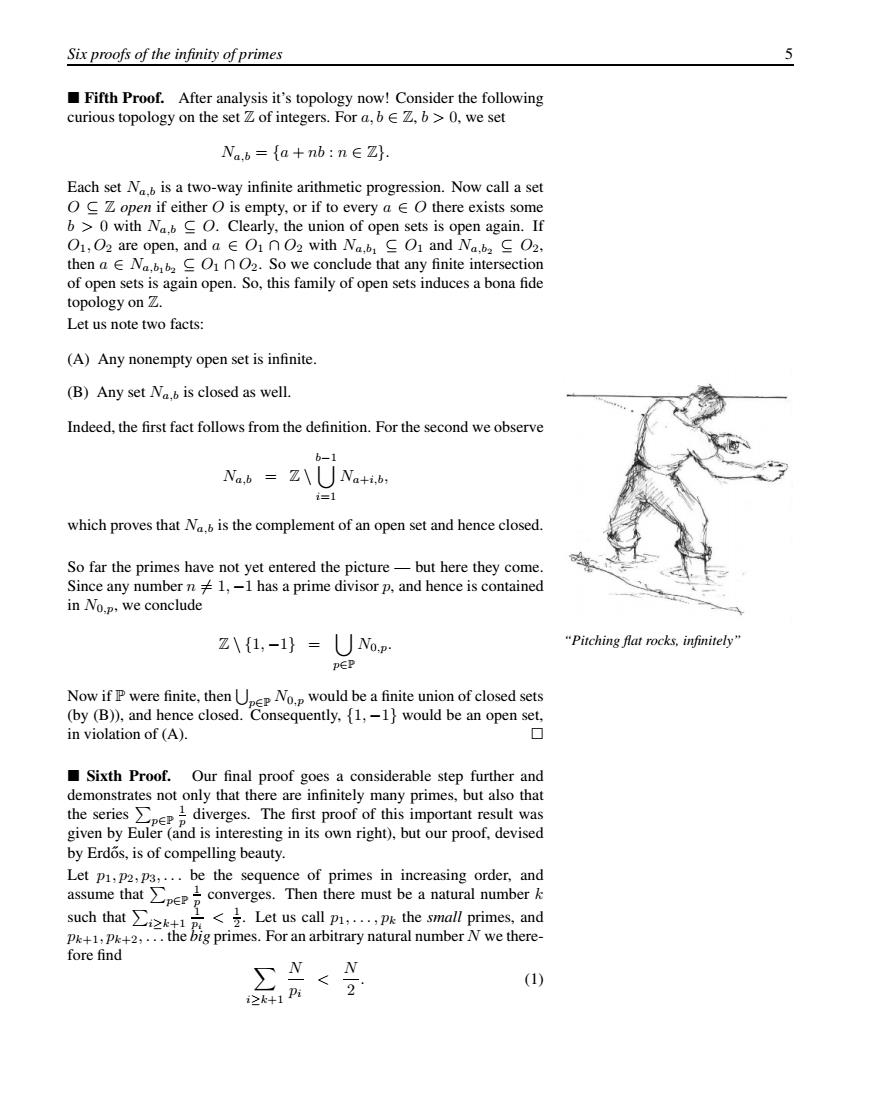正在加载图片...

Six proofs of the infinity of primes J Fifth Proof.After analysis it's topology now!Consider the following curious topology on the set Z of integers.For a,bZ,b>0,we set Na.b={a+nb:n∈Z. Each set N is a two-way infinite arithmetic progression.Now call a set O CZ open if either O is empty,or if to every a E O there exists some b>0 with Na.b O.Clearly,the union of open sets is open again.If 01,02 are open,and a nO2 with Na.b O1 and Na.baO2. then a E Na.bbO1nO2.So we conclude that any finite intersection of open sets is again open.So,this family of open sets induces a bona fide topology on Z. Let us note two facts: (A)Any nonempty open set is infinite. (B)Any set Na.b is closed as well. Indeed,the first fact follows from the definition.For the second we observe b-1 Na.b =Z Nati.b; i=1 which proves that Na.b is the complement of an open set and hence closed. So far the primes have not yet entered the picture-but here they come. Since any number n1,-1 has a prime divisor p,and hence is contained in No.p,we conclude Z\{1,-1}No.p. "Pitching flat rocks,infinitely" pEp Now if P were finite,then No.p would be a finite union of closed sets (by (B)),and hence closed.Consequently,{1,-1 would be an open set, in violation of (A). ▣ Sixth Proof.Our final proof goes a considerable step further and demonstrates not only that there are infinitely many primes,but also that the seriesdiverges.The first proof of this important result was given by Euler(and is interesting in its own right),but our proof,devised by Erdos,is of compelling beauty. Let pi,p2,p3,...be the sequence of primes in increasing order,and assume that∑pee。 converges.Then there must be a natural numberk such that∑≥kt<子.Let us call p,,p the small primes,and Pk+1,Pk+2,...the big primes.For an arbitrary natural number N we there- fore find (1)Six proofs of the infinity of primes 5 Fifth Proof. After analysis it’s topology now! Consider the following curious topology on the set Z of integers. For a, b ∈ Z, b > 0, we set Na,b = {a + nb : n ∈ Z}. Each set Na,b is a two-way infinite arithmetic progression. Now call a set O ⊆ Z open if either O is empty, or if to every a ∈ O there exists some b > 0 with Na,b ⊆ O. Clearly, the union of open sets is open again. If O1, O2 are open, and a ∈ O1 ∩ O2 with Na,b1 ⊆ O1 and Na,b2 ⊆ O2, then a ∈ Na,b1b2 ⊆ O1 ∩ O2. So we conclude that any finite intersection of open sets is again open. So, this family of open sets induces a bona fide topology on Z. Let us note two facts: (A) Any nonempty open set is infinite. (B) Any set Na,b is closed as well. Indeed, the first fact follows from the definition. For the second we observe Na,b = Z \ b −1 i=1 Na+i,b, which proves that Na,b is the complement of an open set and hence closed. “Pitching flat rocks, infinitely” So far the primes have not yet entered the picture — but here they come. Since any number n = 1, −1 has a prime divisor p, and hence is contained in N0,p, we conclude Z \ {1, −1} = p∈P N0,p. Now if P were finite, then p∈P N0,p would be a finite union of closed sets (by (B)), and hence closed. Consequently, {1, −1} would be an open set, in violation of (A). Sixth Proof. Our final proof goes a considerable step further and demonstrates not only that there are infinitely many primes, but also that the series p∈P 1 p diverges. The first proof of this important result was given by Euler (and is interesting in its own right), but our proof, devised by Erdos, is of compelling beauty. ˝ Let p1, p2, p3,... be the sequence of primes in increasing order, and assume that p∈P 1 p converges. Then there must be a natural number k such that i≥k+1 1 pi < 1 2 . Let us call p1,...,pk the small primes, and pk+1, pk+2,... the big primes. For an arbitrary natural number N we therefore find i≥k+1 N pi < N 2 . (1)���